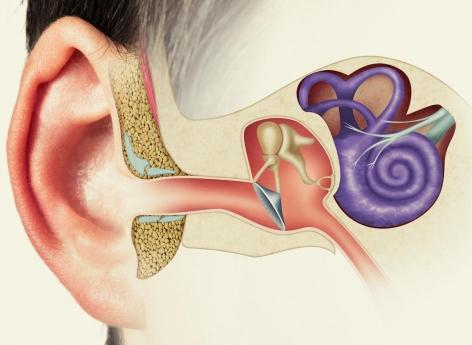THE ESSENTIAL
- Certain types of cells in the inner ear express the proteins necessary for the SARS-CoV-2 virus to enter cells.
- The virus can infect in particular hair cells and, to a lesser extent, Schwann cells.
- The overall percentage of Covid-19 patients who have had ear problems is not known.
–
Many patients with Covid-19 have reported symptoms affecting the ears, including hearing loss and tinnitus. Others have reported dizziness and problems with balance, which suggests the virus could infect the inner ear. A new study by researchers at MIT and Massachusetts Eye and Ear provides evidence that the virus can actually infect cells in the inner ear, including hair cells, which are essential for both hearing and balance. They published their results on October 29 in the journal Communications Medicine.
Ear infection patterns
The researchers used new cellular models of the human inner ear that they developed, as well as tissue from the human inner ear. “Having the models is the first step, and this work now paves a way for working with not only SARS-CoV-2 but also other viruses that affect hearing.”, Notes Lee Gehrke, who co-led the study. Before the onset of the pandemic, researchers began work on a project to develop cell models to study human inner ear infections. Viruses such as cytomegalovirus, mumps virus, and hepatitis viruses can all cause deafness, but it is not known exactly how they do this.
These models enabled researchers to study the effects of SARS-CoV-2 on the ears after virus-positive patients complained of hearing loss, tinnitus and dizziness. In samples from the human inner ear and in cell models derived from stem cells, researchers have found that certain types of cells – in this case hair cells and Schwann cells – express the proteins needed for the virus SARS-CoV-2 enters cells. These proteins include the ACE2 receptor, which is found on the surface of cells, and two enzymes – called furin and serine 2 transmembrane protease – which help the virus to fuse with the host cell.
Paying increased attention to hearing problems
The researchers have thus shown that the virus can actually infect the inner ear, in particular hair cells and, to a lesser extent, Schwann cells. In particular, these are the vestibular hair cells which are involved in detecting head movements and maintaining balance. Cochlear hair cells, which are involved in hearing, are much more difficult to obtain or generate in a cellular model. However, researchers have shown, in mouse models, that they also contain proteins that allow entry of SARS-CoV-2.
Although this study suggests that Covid-19 can cause hearing and balance problems, the overall percentage of sufferers who have had ear problems is not known. “Initially, this was because screening tests were not readily available to patients who were diagnosed positive, and also, when patients had more life-threatening complications, they did not pay much attention to their hearing., concluded Konstantina Stankovic who co-led the study. We still don’t know what the impact is, but our findings do call for increased attention to audio-vestibular symptoms in people exposed to the virus..”
Several possible entry routes
The authors hypothesize that the possible routes for the virus to enter the ears include the Eustachian tube, which connects the nose to the middle ear. “The virus could also escape from the nose through small openings surrounding the olfactory nerves, estime Konstantina Stankovic. This would allow it to enter the brain space and infect the cranial nerves, including the one that connects to the inner ear..”
–

